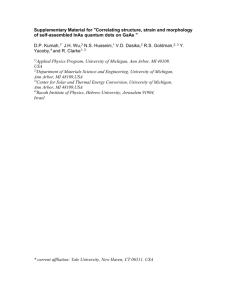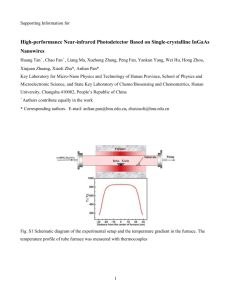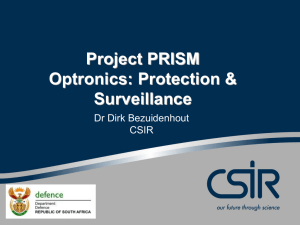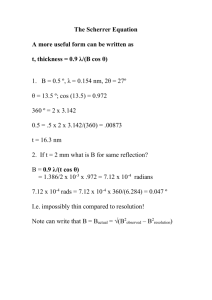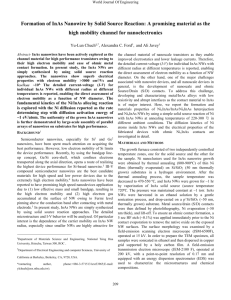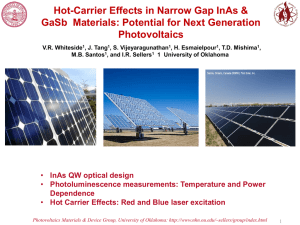APL_supplemental_material_final_v2
advertisement
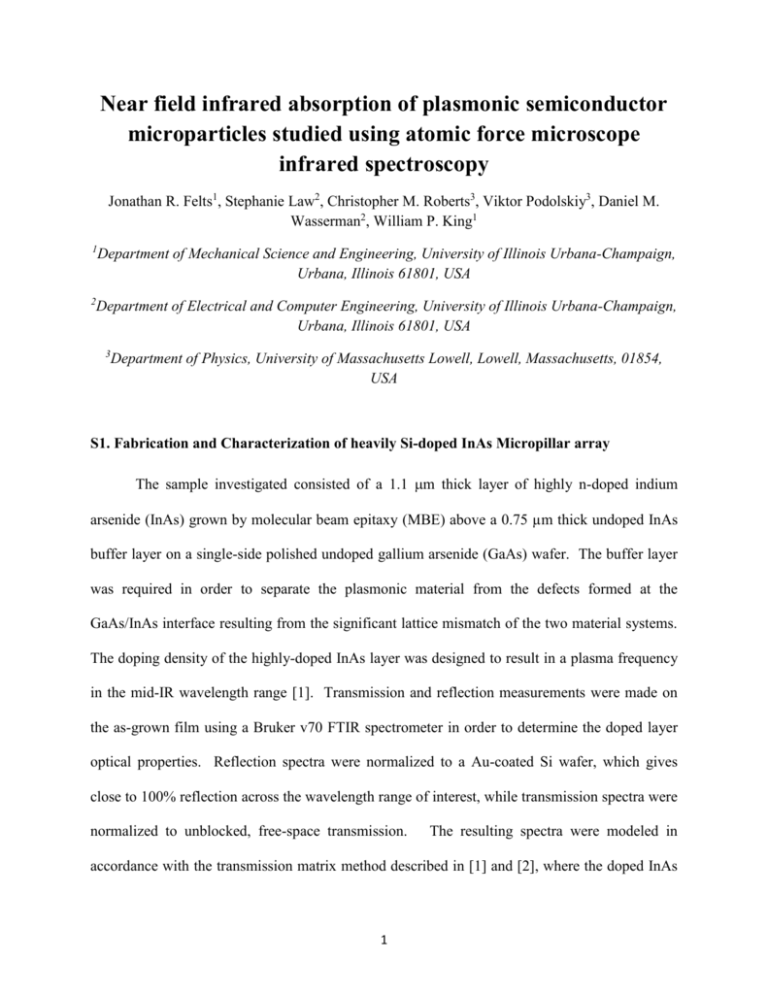
Near field infrared absorption of plasmonic semiconductor microparticles studied using atomic force microscope infrared spectroscopy Jonathan R. Felts1, Stephanie Law2, Christopher M. Roberts3, Viktor Podolskiy3, Daniel M. Wasserman2, William P. King1 1 2 Department of Mechanical Science and Engineering, University of Illinois Urbana-Champaign, Urbana, Illinois 61801, USA Department of Electrical and Computer Engineering, University of Illinois Urbana-Champaign, Urbana, Illinois 61801, USA 3 Department of Physics, University of Massachusetts Lowell, Lowell, Massachusetts, 01854, USA S1. Fabrication and Characterization of heavily Si-doped InAs Micropillar array The sample investigated consisted of a 1.1 m thick layer of highly n-doped indium arsenide (InAs) grown by molecular beam epitaxy (MBE) above a 0.75 µm thick undoped InAs buffer layer on a single-side polished undoped gallium arsenide (GaAs) wafer. The buffer layer was required in order to separate the plasmonic material from the defects formed at the GaAs/InAs interface resulting from the significant lattice mismatch of the two material systems. The doping density of the highly-doped InAs layer was designed to result in a plasma frequency in the mid-IR wavelength range [1]. Transmission and reflection measurements were made on the as-grown film using a Bruker v70 FTIR spectrometer in order to determine the doped layer optical properties. Reflection spectra were normalized to a Au-coated Si wafer, which gives close to 100% reflection across the wavelength range of interest, while transmission spectra were normalized to unblocked, free-space transmission. The resulting spectra were modeled in accordance with the transmission matrix method described in [1] and [2], where the doped InAs 1 layer’s permittivity is given by the Drude formalism, with only the plasma wavelength and scattering time as fitting parameters. Using this technique, our doped InAs layer was determined to have a plasma wavelength of p=5.48 m, with a scattering time of approximately Г = 1x10-13 s. The resulting wavelength is a function of the silicon doping, and does not depend upon the dimensions of the pucks [1]. The top doped layer was then processed into an array of pucks with a nominal diameter of 1.7 m and a periodicity of 3.4 m using standard photolithographic techniques. The pucks were etched using a mixture of 1:1:10 HBr:HNO3:H2O, leaving the undoped InAs layer intact underneath. Reflection and transmission spectra for these pucks were taken in a similar fashion to the as-grown wafers, as described above. Weak dips in transmission and reflection were observed at ~ 5.73µm, in spectral agreement with our finite-element model of the fabricated structure, using the permittivity determined from the measurements of our as-grown material. A slight spectral shift between transmission and reflection dips is observed in our data, which was also observed in previous samples and in our COMSOL model. This is believed to result from the combination of (angle-dependent) scattering and reflection/transmission from the puck sample. The size and spacing of the pucks in the array preclude the excitation of collective resonances by the laser used in experiments [3]. We removed the GaAs substrate from the sample to ensure the laser light was absorbed mainly by the pillars and not the substrate. Following initial, far-field, transmission and reflection measurements, the processed film was attached face-down to a glass slide with crystal bond wax, leaving the GaAs substrate exposed. The sample was then etched overnight in a solution of 1:3:16 NH4OH:H2O2:H2O, which selectively removed the GaAs from the epitaxiallygrown InAs. The remaining material and glass slide carrier was placed in acetone to remove the 2 wax and release the patterned InAs, leaving the InAs film freely floating. After diluting the acetone with water, the film was carefully placed onto a submerged zinc selenide (ZnSe) prism and allowed to air-dry. The final structure, now ready for near-field optical characterization, consisted of the doped InAs pucks supported by a thin undoped InAs layer, resting on the ZnSe prism. S2. Numerical calculations of light propagation through micropillar arrays Numerical solutions of Maxwell equations in the pillar arrays were performed by a commercial finite-element method (FEM), partial differential equation (PDE) solver, COMSOL multiphysics. The system was approximated as periodic planar array of cylindrical pillars (pucks). The permittivity of an individual puck was approximated by the Drude model, whose parameters were deduced from measurements of the transmission and reflection of an unpatterned structure. These 3D calculations allow us to compute both microscopic field distributions across the unit cell, and macroscopic parameters (transmission and reflection) of the structure. In a separate set of calculations, a transfer-matrix technique was used to compute the spectrum of guided modes in the structure comprising of only a GaAs substrate, an undoped InAs buffer layer and air. The sharp satellite resonances in the reflection spectrum from FEM calculations were then matched to the guided modes in the puck-less system, shifted by the integer multiples of the grating vectors corresponding to periodicity of a unit cell. References [1] S. Law, D. C. Adams, A. M. Taylor, and D. Wasserman, Opt. Express 20, 12155 (2012) 3 [2] Y. B. Li, A. Stradlng, T. Knight, J. R. Birch, R. H. Thomas, C. C. Phillips, and I. T. Ferguson, Semicond. Sci. Technol. 8, 101 (1993) [3] R. Adato, A. A. Yanik, J. J. Amsden, D. L. Kaplan, F. G. Omenetto, M. K. Hong, S. Erramilli, and H. Altug, PNAS 106, 46, 19227 (2009) 4
